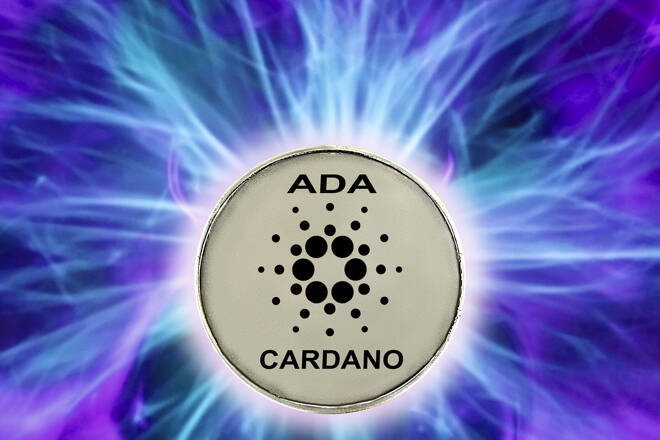Advertisement
Advertisement
ADA Price Prediction: Bulls to Target $0.400 on IOHK Network News
By:
It was a choppy session for ADA on Friday. However, IOHK network news out trumped the impact of the US Jobs Report that raised bets of a Fed rate hike.
Key Insights:
- ADA rose by 0.26% to end the Friday session at $.0.384.
- Network updates, the Input Output HK (IOHK) weekly development report, and US economic indicators delivered a mixed session.
- The technical indicators are bullish, bringing $0.400 into play.
ADA rose by 0.26% on Friday. Partially reversing a 2.30% fall from Thursday, ADA ended the day at $0.384. Despite the bullish session, ADA fell short of the $0.400 handle for the second consecutive session.
A mixed start to the day saw ADA rise to an early high of $0.385. Coming up short of the First Major Resistance Level (R1) at $0.392, ADA declined to a mid-morning low of $0.376. However, finding support at the First Major Support Level (S1) at $0.376, ADA revisited the $0.385 handle before easing back.
IOHK Weekly Development Report and Network News Deliver Support
Input Output HK (IOHK) released the Weekly Development Report on Friday. The report revealed a rise in launched projects on Cardano, delivering ADA price support.
According to the April 7 report,
- 122 projects launched on the Cardano network, up by three from March 31.
- Projects building on the Cardano network totaled 1,221, unchanged from the previous report.
- Plutus scripts totaled 7,597, of which 2,353 were Plutus V2 scripts. As of March 24, Plutus scripts stood at 7,546.
Before the Vasil hard fork, the number of projects launched on Cardano had stood at 98, with 1,100 projects building on the Cardano network.
Other stats included 64.2 million transactions (Previous Report: 63.9m), 8.09 million native tokens (PR: 8.06 million), and 71,386 token policies (PR: 71,128).
While the upswing in launched projects on the Cardano network was positive, news of Cardano integrating CHARLi3 was also bullish. According to the CHARLi3 update, the integration will pave the way to fully decentralization for the Cardano Community.
Liquid co-founder DC had this to say,
“Charli3 is Cardano’s first decentralized oracle infrastructure on mainnet, working with talented developers that built this protocol and seeing their clear vision for the evolution of Cardano DeFi has been insightful and super motivating.”
US Economic Indicators Fail to Move the Dial
The US Jobs Report failed to spur a breakout afternoon session despite a further tightening in the US labor market.
Nonfarm payrolls increased by 236k v a forecasted 239k, with average hourly earnings up 4.2% year-over-year versus 4.6% in February. However, the US unemployment rate fell from 3.6% to 3.5% despite a rise in the participation rate from 62.5% to 62.6%.
The numbers supported a more hawkish Fed and raised the prospects of a May interest rate hike.
According to the CEM FedWatch Tool, the probability of a 25-basis point interest rate hike jumped from 49.2% to 67.0%. The stats supported FOMC member James Bullard’s more hawkish stance.
The Day Ahead
Input Output HK (IOHK) updates will remain the focal point. However, a lack of network updates should leave the broader crypto market to influence.
US regulatory and lawmaker activity will draw interest, with investors needing to track Binance and Coinbase (COIN)-related news.
ADA Price Action
This morning, ADA was up 0.78% to $0.387. A mixed start to the day saw ADA slip to an early low of $0.381 before rising to a high of $0.389.
Technical Indicators
ADA has to avoid the $0.382 pivot to target the First Major Resistance Level (R1) at $0.387. A move through the Friday high of $0.385 would support a bullish session. However, Cardano network updates and the broader crypto market would need to provide support.
In case of a breakout, ADA would likely test the Second Major Resistance Level (R2) at $0.391. The Third Major Resistance Level (R3) sits at $0.400.
A fall through the pivot ($0.382) would bring the First Major Support Level (S1) at $0.378 into play. However, barring another extended broad-based crypto sell-off, ADA should avoid sub-$0.375 and the Second Major Support Level (S2) at $0.373. The Third Major Support Level (S3) sits at $0.364.
Today, the EMAs and the 4-hourly candlestick chart (below) sent bullish signals.
ADA sat above the 50-day EMA, currently at $0.384. The 50-day EMA pulled away from the 200-day EMA, with the 100-day EMA widening from the 200-day EMA, delivering bullish signals.
Avoiding the 50-day EMA ($0.384) would support a breakout from R1 ($0.387) to give the bulls a run at R2 (0.391). However, a fall through the 50-day EMA ($0.384) would bring S1 ($0.378) and the 100-day EMA ($0.377) into view. A fall through the 50-day EMA would send a bearish signal.
About the Author
Bob Masonauthor
With over 28 years of experience in the financial industry, Bob has worked with various global rating agencies and multinational banks. Currently he is covering currencies, commodities, alternative asset classes and global equities, focusing mostly on European and Asian markets.
Advertisement
